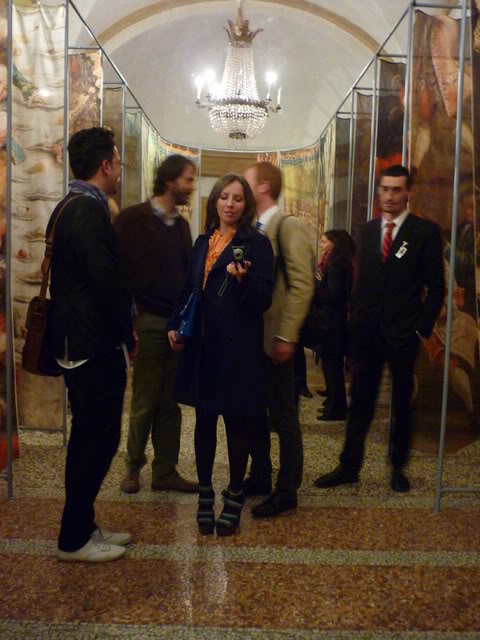I had been putting off going to the Cy Twombly exhibition because I didn't want to be disappointed. Although I find the building magnificent, the exhibitions drive me to despair: Duchamps, Dali, Gilbert and George, yawn, yawn, yawn. Surely it would be far more inspiring and educational for the art-viewing public to have regular exposure to less well known artists. When Nicholas Penny was appointed as the new director of the National Gallery earlier this year, one of the first things he said to the press was that blockbuster exhibitions don't teach anyone anything, and insisted he would concentrate instead on erudite shows of lesser-known artists. Finally, I thought, a man with some bloody good sense. As of yet, he hasn’t been director long enough to make good on his word, but he appears to have struck a chord with other galleries if this exhibition is anything to judge by.
The human mind must derive immense pleasure in the making of cross references, patterns, and connections in works of art; whether literature, music, or the visual, as we seem to love saying things like, “this band sounds like a cross between early David Bowie and Brahms!” or “this author is the new Hemmingway.” Twombly excels at this sort of cross-pollination and there are references, both ancient and modern, aplenty. Twombly makes no secret of his love of great poets, especially Rilke and Homer, but for me, the subtle or even unacknowledged connections were more intriguing. Twombly's early works, for instance, reminded me very much of some of the commercial work of Gary Fernandez, a modern illustrator. While the similarities are entirely tenuous (though I suppose it is possible Fernandez takes Twombly as inspiration), the vibrant, fresh, looseness of the Twombly is very evident in the illustrations of Fernandez. There’s something very illustratory (nice word, I know) in general about Twombly's early pieces which give them a surprisingly modern sensibility.


One of my favourite paintings from the exhibition, Treatise on the Veil, was entirely different from any other work displayed. Evidently these paintings were inspired by an Eadweard Muybridge photograph of a bride in motion. Muybridge was a photographic pioneer, using multiple cameras to create stop-motion action sequences of things like horses galloping or a couple dancing. Twombly’s series of six interlinked panels brilliantly echoes the concept (and the inspiration of a stop motion bride seemingly floating under her veil) while simultaneously remaking the technique into something completely new.


Quattro Stagioni, perhaps Twombly’s most well known work (the Modern's publicity for the exhibition is taken from this work), is hung in two different versions, completed roughly around the same time, 1993-95. These reminded me of something, but it took me a while to remember that, especially Estate, echoed the work of Clyfford Still, which I'd seen at an exhibition in Washington DC in 2003. You can see the difference between the two immediately, but that's hardly the point. The stylistic similarities are perhaps more intriguing. Still is far more controlled; he’s cleaner, harsher, more primitive, while Twombly is all whimsy, ragged, carefree, reckless insouciance, but it was Still's yellow painting below that I remembered and brought the resemblance to mind. I love discovering connections like these – as I'm not approaching this from an academic perspective, I don't have to consider the implications of whether they actually knew each other. I can simply enjoy the thrill of recognition and the remembrance and clarification of that recognition. I suppose it's this sort of thing that makes an unpersonal gallery exhibition into a far more personal experience.
The first two are the Twombly's, and Still's work is below.




The last series of work in the exhibition is from Twombly’s 2005 Bacchus, Psilax, Mainomenos (for those non Greek speaking, anti-mythologists, Bacchus is the Roman equivalent of the Greek god of wine Dionysus, and even if you do know that, you probably don’t know that his rites were celebrated with orgies and animals being torn to pieces and their raw flesh consumed – see Euripides’ The Bacchae for more fun and games). This was the only time where I felt the work on display represented something quite different to me than it did to the curators. The accompanying blurb indicated that Twombly’s initial inspiration for the work was Homer’s Iliad, which seemed sensible enough given Twombly’s classical leanings. The curators then went on to say that the brilliant, massive, red looped paintings were an expression of pure drunken abandon. Having three of the paintings in the room at once, there was little euphoria to be felt. They are marvellous pieces of work, but all I could think of was Christopher Logue’s War Music, a contemporary, pseudo-translation of the Iliad, with its haunting evocation of war, “Dust like red mist/Pain like chalk on slate. Heat like Arctic” and also “Moving at speed, but absolutely still/The arrow in the air. Death in a man/as something first perceived by accident.” In particular, the long streaks of dripped down red paint create a sense of morbid frenzy, the body exploding into a fine red mist. Not exactly jubilant...

Still, I found the exhibition to be absolutely superb (how many adverbs in one post?). I was so enamoured that I sought out a feedback form from the information desk and filled it in then and there. It basically said, “more like this please.” I hope they take my advice.




No comments:
Post a Comment